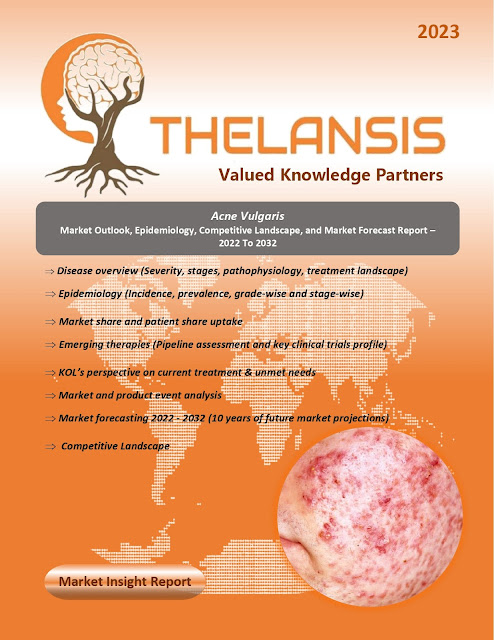Blastic Plasmacytoid Dendritic Cell Neoplasm (BPDCN) – Market Outlook, Epidemiology, Competitive Landscape, and Market Forecast Report – 2023 To 2033
Blastic plasmacytoid dendritic cell neoplasm (BPDCN) is a rare, aggressive hematologic malignancy with an unfavorable prognosis. It predominantly manifests with cutaneous lesions, which are frequently asymptomatic and can range from solitary to multiple, covering a wide area. These skin manifestations can vary from bruise-like discolorations to plaques or nodules. Additionally, patients may exhibit bone marrow involvement, infiltration of the central nervous system (CNS), lymph node enlargement, spleen enlargement, and various degrees of cytopenias. Within the dendritic cell and histiocytic neoplasms category, BPDCN is grouped alongside plasmacytoid dendritic cell proliferation associated with myeloid neoplasms. BPDCN primarily affects older men, with a male-to-female ratio ranging from 3:1 to 5:1, typically diagnosed between 60 and 70. The most common initial clinical presentation of BPDCN involves asymptomatic skin lesions, occurring in approximately 90% of patients at diagnosis. These skin lesions can manifest as areas resembling bruises, patches, plaques, or nodules. While some individuals may exhibit exclusively skin-related symptoms, most also demonstrate BPDCN involvement in the bone marrow, lymph nodes, and visceral organs. In rare instances, patients may present with a leukemic phase of the disease without any apparent skin lesions. CNS involvement is observed in around 30% of patients, and BPDCN can manifest in less common sites such as soft tissues, the breast, gallbladder, tongue, and lung. Some patients may also have concomitant myeloid neoplasms like CMML, MDS, and AML, referred to as prior or concurrent hematologic malignancy (PCHM). Although a small percentage of patients may have isolated skin involvement, most will also have BPDCN detected in the bone marrow, lymph nodes, or visceral organs. Unfortunately, the prognosis for most patients is grim, with a survival period of only 10 to 14 months post-diagnosis, despite receiving various chemotherapy treatments. Allogeneic stem cell transplantation (alloSCT) represents the sole potentially curative treatment option for BPDCN. However, due to the preponderance of this disease in older individuals, only a minority of BPDCN patients are suitable candidates for alloSCT. BPDCN predominantly affects males, with a male-to-female ratio of approximately 3.3:1, typically occurring in the seventh or eighth decade of life.
·
It has an estimated incidence rate of about
0.04 cases per 100,000 individuals, although it can manifest at any age,
including childhood.
Thelansis’s
“Blastic Plasmacytoid Dendritic Cell Neoplasm (BPDCN) Market Outlook,
Epidemiology, Competitive Landscape, and Market Forecast Report – 2023 To 2033"
covers disease overview, epidemiology, drug utilization, prescription share
analysis, competitive landscape, clinical practice, regulatory landscape,
patient share, market uptake, market forecast, and key market insights under
the potential Blastic Plasmacytoid Dendritic Cell Neoplasm (BPDCN) treatment
modalities options for eight major markets (USA, Germany, France, Italy, Spain,
UK, Japan, and China).
KOLs insights of Blastic Plasmacytoid
Dendritic Cell Neoplasm (BPDCN) across 8 MM market from the centre of
Excellence/ Public/ Private hospitals participated in the study. Insights
around current treatment landscape, epidemiology, clinical characteristics,
future treatment paradigm, and Unmet needs.
Blastic
Plasmacytoid Dendritic Cell Neoplasm (BPDCN) Market Forecast Patient
Based Forecast Model (MS. Excel Based Automated Dashboard), which Data Inputs
with sourcing, Market Event, and Product Event, Country specific Forecast
Model, Market uptake and patient share uptake, Attribute Analysis, Analog
Analysis, Disease burden, and pricing scenario, Summary, and Insights.
Thelansis Competitive Intelligence (CI) practice
has been established based on a deep understanding of the pharma/biotech
business environment to provide an optimized support system to all levels of
the decision-making process. It enables business leaders in forward-thinking
and proactive decision-making. Thelansis supports scientific and commercial
teams in seamless CI support by creating an AI/ ML-based technology-driven
platform that manages the data flow from primary and secondary sources.
Tags: Blastic
Plasmacytoid Dendritic Cell Neoplasm (BPDCN), Blastic Plasmacytoid Dendritic
Cell Neoplasm (BPDCN) market outlook, Blastic
Plasmacytoid Dendritic Cell Neoplasm (BPDCN) competitive
landscape, Blastic Plasmacytoid Dendritic Cell Neoplasm (BPDCN) market forecast, Thelansis, Primary market research, KOL
insights, Competitive Intelligence (CI)




Comments
Post a Comment